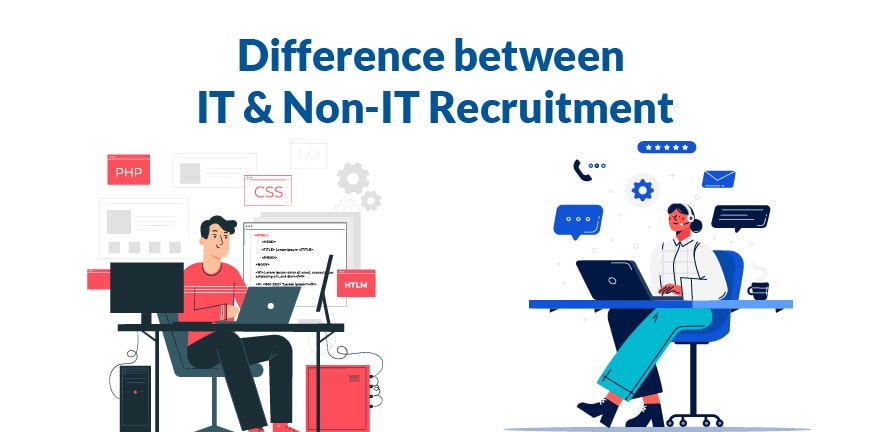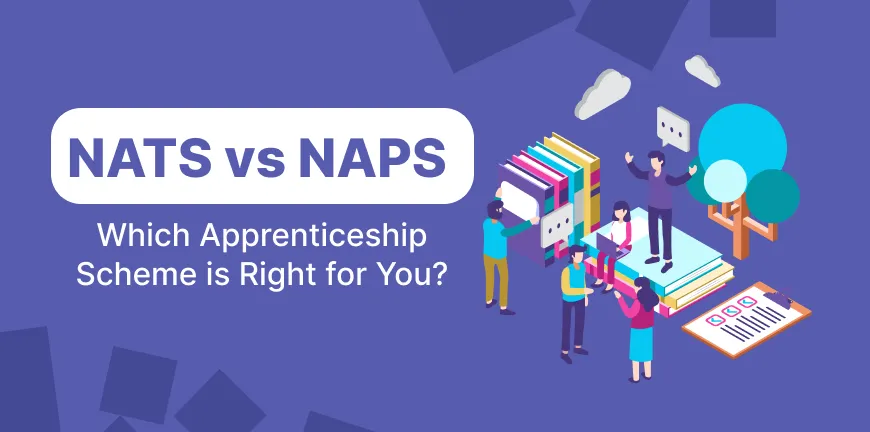
Non-IT Recruitment: Roles & Responsibilities, Examples
22/08/2023
Difference Between IT and non-IT Recruitment
24/08/2023- 7 Key Benefits of Apprenticeship for Businesses
- The Origin of Apprenticeship in India
- National Apprenticeship Promotion Scheme (NAPS)
- National Apprenticeship Training Scheme (NATS)
- NAPS vs NATS
- Who is eligible to undergo apprenticeship training under NAPS?
- Who is eligible to undergo apprenticeship training under NATS?
- How Much Can One Earn Under NAPS and NATS During Training?
- How is an establishment defined under the Act?
- What are the eligibility criteria for establishments to avail benefits under NAPS?
- How can an establishment engage apprentices?
- Can an establishment with presence in multiple locations register centrally under NAPS?
- Registration of establishment under NATS – Procedure
- How can establishments onboard students under NATS?
- Can We Help You in Your NAPS or NATS Apprenticeship Journey?
You have a good idea but now you need the right people to grow when everything around you is falling apart? If you are budget conscious and people-minded at the same time, then that’s a good start. You have the right frame of mind when you realise that people are what keeps the business running.
But how do you ensure that you have the right talent on board and that your money is well-utilised? Perhaps permanent hiring is not the answer. Is it internship or apprenticeship that will work the magic for your business? If you have decided on apprenticeship and are a small or medium-sized business in India, we’d say there is no better time or place. Apprenticeship is seeing unprecedented growth in our country.
The Apprenticeship Act of 1961 was the first major step undertaken by the Government of India. It laid out rules that establishments and potential apprentices must follow during apprenticeship or when instituting an apprenticeship program. But it was not until 2016 that the National Apprentice Promotion Scheme (NAPS) was established, and that the National Apprentice Training Scheme (NATS) came into being.
In this article, we will look at how you can register an establishment under the Apprenticeship Act of 1961, but let us look at the benefits of apprenticeship, the two different apprenticeship options available in India, and how to register for apprenticeship first as a candidate.
7 Key Benefits of Apprenticeship for Businesses
Engaging in apprenticeship programs is advantageous for businesses. Let us see why.
- Addresses skills shortage, especially that of soft skills like communication
- Provides an opportunity to improve organisational productivity
- Reduces cost of hiring significantly
- Reduces operating costs by not paying benefits such as provident fund and insurance
- Senior staff can get free if job is well delegated to juniors
- Gets the viewpoint of a younger generation
- Improves employee engagement and retention
- Ensures compliance and freedom from legal problems
The Origin of Apprenticeship in India
In 2016, the Government of India took a big bold step to make apprenticeship relevant in the country. India introduced the NAPS and the NATS schemes. Through these schemes, India hopes to increase the number of apprentices to about 50 lakhs soon. While in NAPS, most of the training is non-technical, in NATS, the students are taught more advanced topics such as IoT, Blockchain, AI and Robotics etc.
National Apprenticeship Promotion Scheme (NAPS)
Launched in 2016, the NAPS program by the Ministry of Skill Development & Entrepreneurship aims to promote apprenticeship training to promote the development of skills in the youth.
It also benefits businesses and industries, as they can save money on pensions and benefits which they would have to offer an employee.
The scheme encourages companies to institute apprenticeship programs by paying up to 25% of the apprentice’s salary, to a maximum of 1500.
National Apprenticeship Training Scheme (NATS)
NATS training aims to provide apprenticeship training to graduates and diploma holders to enhance their skills. The scheme run by the Ministry of Education hopes to educate people across industries like manufacturing, healthcare, hospitality and IT.
Under this scheme, organisations will be reimbursed up to 4500 of their costs by the Government of India for training engineering graduates and up to Rs.4000 in case of non-engineering graduates.
NAPS vs NATS
Semi-skilled or even unskilled people benefit from NAPS training. NATS is for graduates and diploma holders who want a stepping stone into their respective professions. NAPS is generally for non-engineering disciplines whereas NATS is generally for engineering disciplines. An apprentice under NATS is likely to get paid more by the business. There are separate training providers for NATS and NAPS.
Who is eligible to undergo apprenticeship training under NAPS?
Individuals over the age of 14 can undergo NAPS training, except in certain industries that involve hazards. They need to complete a minimum of 5th grade (only optional trades) to register as an apprentice for any job that allows it.
Who is eligible to undergo apprenticeship training under NATS?
To be eligible for the NATS apprenticeship program, all candidates must satisfy the following requirements.
- Applicant must be at least 16 years of age as on the date of the application
- Applicant must hold a degree or a diploma to start under NATS
- Applicants trained under another skill development program of the Government are not eligible for NATS
- Applicant must not have his/her own business
- Applicant must not be a government employee dismissed from service
How Much Can One Earn Under NAPS and NATS During Training?
Under both the NAPS and NATS schemes, the government provides employers with reimbursements during the training period. The employers will also be paying the apprentices a good amount.
A basic training cost of up to 7500 for a max of 500 hours for each candidate is reimbursed by the Government of India.
In NATS, candidates will be reimbursed up to 9000 during their training by the Government of India. So yes, in NATS, apprentices are paid higher during training but the final salary during training will depend on the employer.
How is an establishment defined under the Act?
An employer/establishment under the apprenticeship act is any organisation or business entity along with its departments and branches (wherever they are located) that is involved in an industry capable of providing on the job training to their apprentices. All establishments that have a workforce of more than 30 employees (regular and contractual are mandated to involve 2.5 to 15% of their workforce in apprenticeship. For establishments of 4 to 29 employees, apprenticeship is optional. Establishments with a workforce of 3 or less employees cannot engage in apprenticeship.
What are the eligibility criteria for establishments to avail benefits under NAPS?
Every organisation will want to claim the benefits under NAPS as it is crucial to facilitating favourable business outcomes. But not all of them would be eligible to avail these benefits. Let us look at the eligibility criteria now.
- Contracts submitted by the establishment on the portal must be approved by the specific apprenticeship advisor.
- All courses under the apprenticeship program run by the company must be NSQF aligned.
- The assessments at the end of each program will be carried out jointly by the establishment and the NCVT (for Designated Trades) or the concerned Sector Skill council (for Optional trade).
How can an establishment engage apprentices?
Access the apprenticeship portal to engage candidates under NAPS. Here are the things you can do as an establishment to attract and onboard apprentices.
- Add notifications on the portal for any apprenticeship opportunities that are open right now
- Search for and shortlist candidates for suitable roles in specific regions and with the required skills
- Issue offers to candidates whom you are convinced have the necessary skills
- Sign the apprenticeship contract with the specific apprentice you want to onboard
- Submit the apprenticeship contract for the approval of the apprenticeship advisor
Can an establishment with presence in multiple locations register centrally under NAPS?
As per definitions made in the Apprenticeship Act, 1961.
- “Employer” is anyone who employs one or more persons in an establishment for a fixed pay or anyone entrusted with their supervision and control.
- “Establishment” refers to any place where an industry is carried on. An establishment may consist of different departments and branches and wherever they are situated, they are considered part of the establishment.
- The establishment can operate in a centralised or a decentralised manner. If operating with separate branches and a corporate office, then the details must be mentioned on the portal.
Registration of establishment under NATS – Procedure
Establishments must register on the NATS 2.0 portal before they can post their skill requirements and find apprentices online.
Establishments can opt for a partial or a full reimbursement or no reimbursement for their apprenticeship training programs.
The establishment then must fill in the below details.
- Number of people employed by the company (contractual/regular/seasonal)
- Sector and region the company belongs to (central/state/private)
- Udyog Aadhaar number and PAN/TAN
- Type of establishment and the year of establishment
- Details of establishment head
- Address of the office registered
- Details for login
How can establishments onboard students under NATS?
Establishments can onboard eligible persons as an apprentice under NATS in two ways.
- Posting an advertisement:
Establishment will post an advertisement to which several people will apply
- Bulk Contract Creation:
One or more student enrolment IDs are entered and post entering the training details also, each agreement is made into a contract.
Can We Help You in Your NAPS or NATS Apprenticeship Journey?
Are you looking for a suitable partner in your NAPS/NATS apprenticeship journey? Want only the best candidates for apprenticeship?
As a NAPS and NATS service provider, Alp Consulting, a reputed HR consulting company gives you access to qualified candidates with the right background, aptitude and attitude.
Alp will also work with you to get the timely stipend reimbursement from the Government both during training and after for both NAPS as well as NATS.
We also train apprentices for both designated as well as optional trades. That’s a 360-degree solution for NAPS/NATS apprenticeship in India. Talk to us today and we can together work on a plan to make your business grow with apprenticeship.
Contact Us For Business Enquiry

Suresh Ramkrishna
Suresh Ramkrishna is the Operations Manager at Alp Consulting Ltd., with over 30 years of extensive experience spanning recruitment operations, sourcing, supply chain management, and client relations. At Alp, he leads the Search & Staffing Practice, specializing in bilingual and niche skill hiring while overseeing Japanese language and TITP (Technical Intern Training Program) initiatives. He also manages NAPS (National Apprenticeship Promotion Scheme) training programs, fostering skill development and workforce readiness across industries. Previously, he spent over two decades in the apparel export industry, managing vendor development and international sourcing for top global brands. Suresh’s leadership blends strategic talent acquisition with operational excellence across diverse industries.




